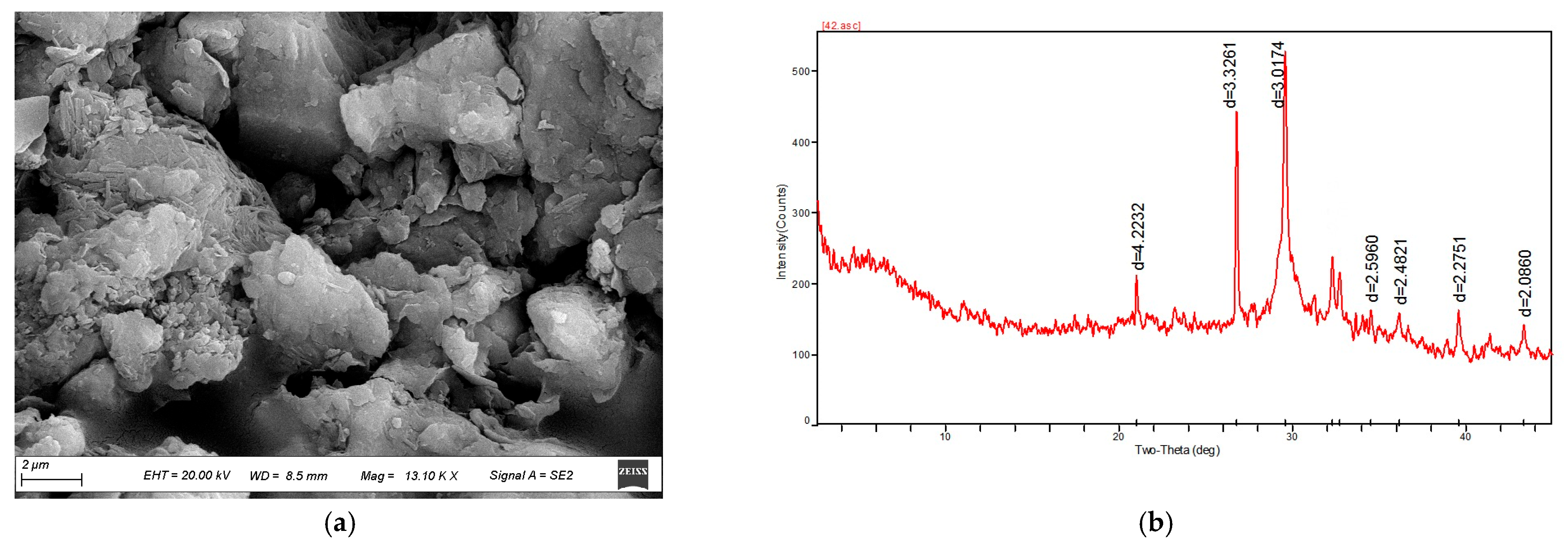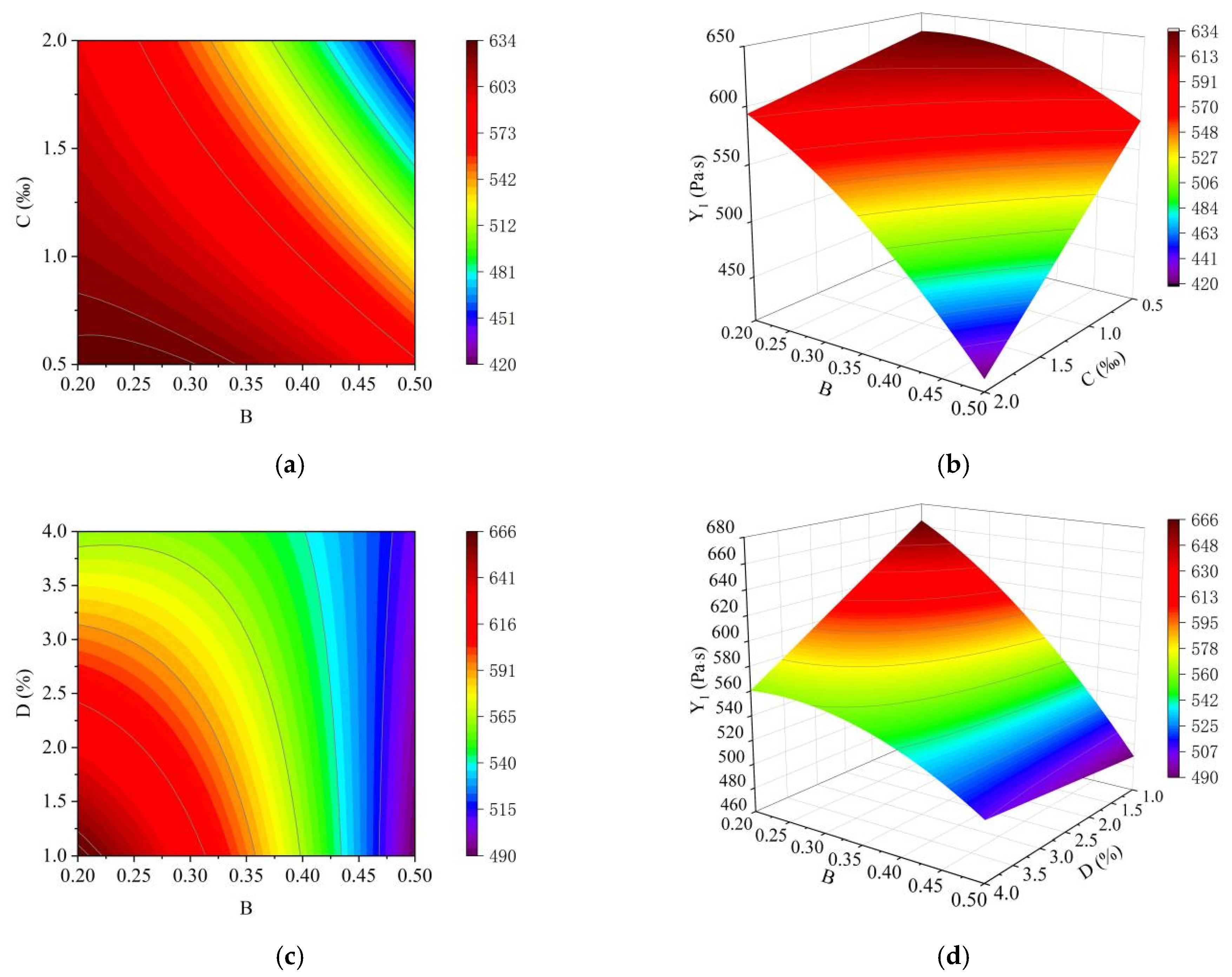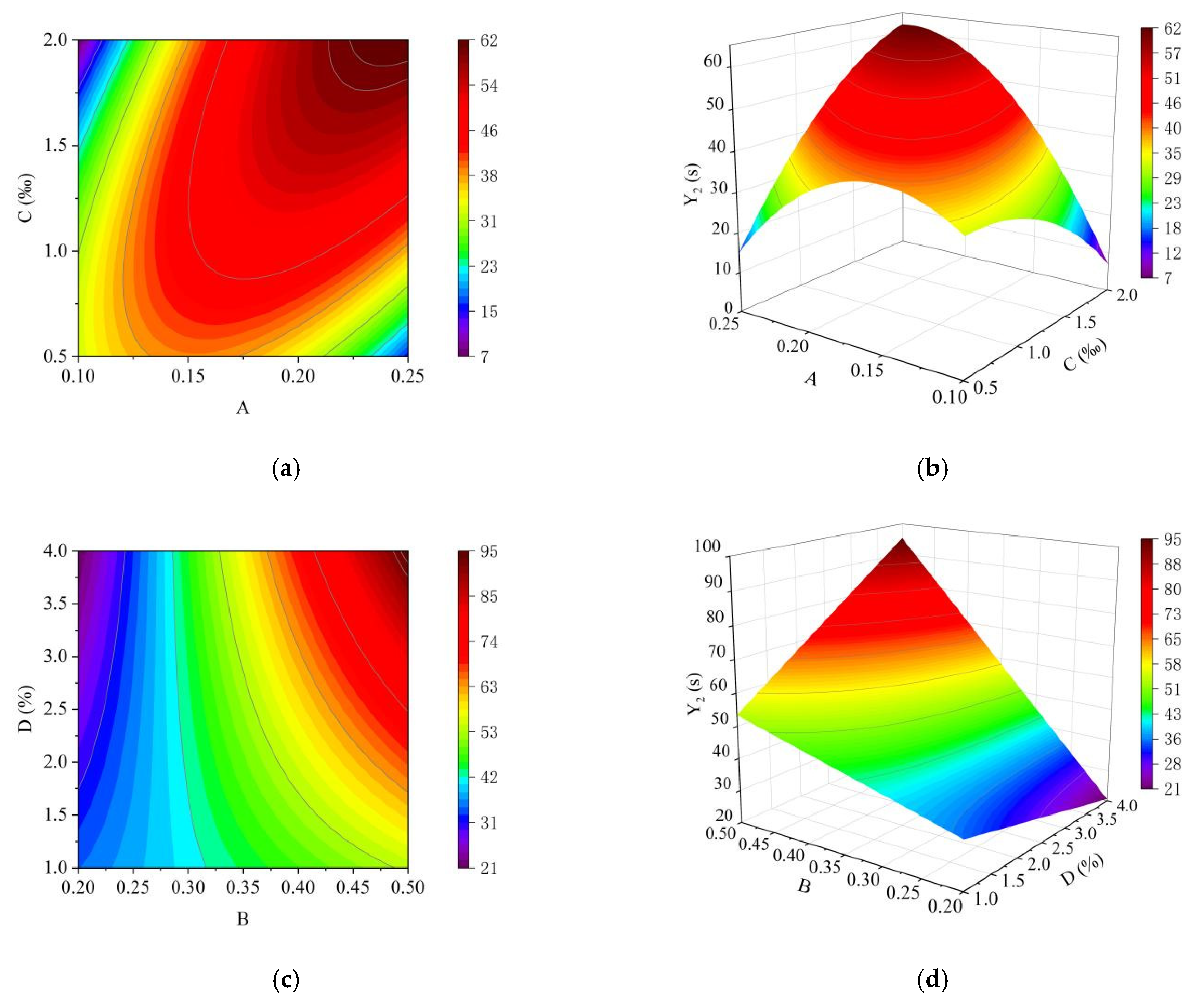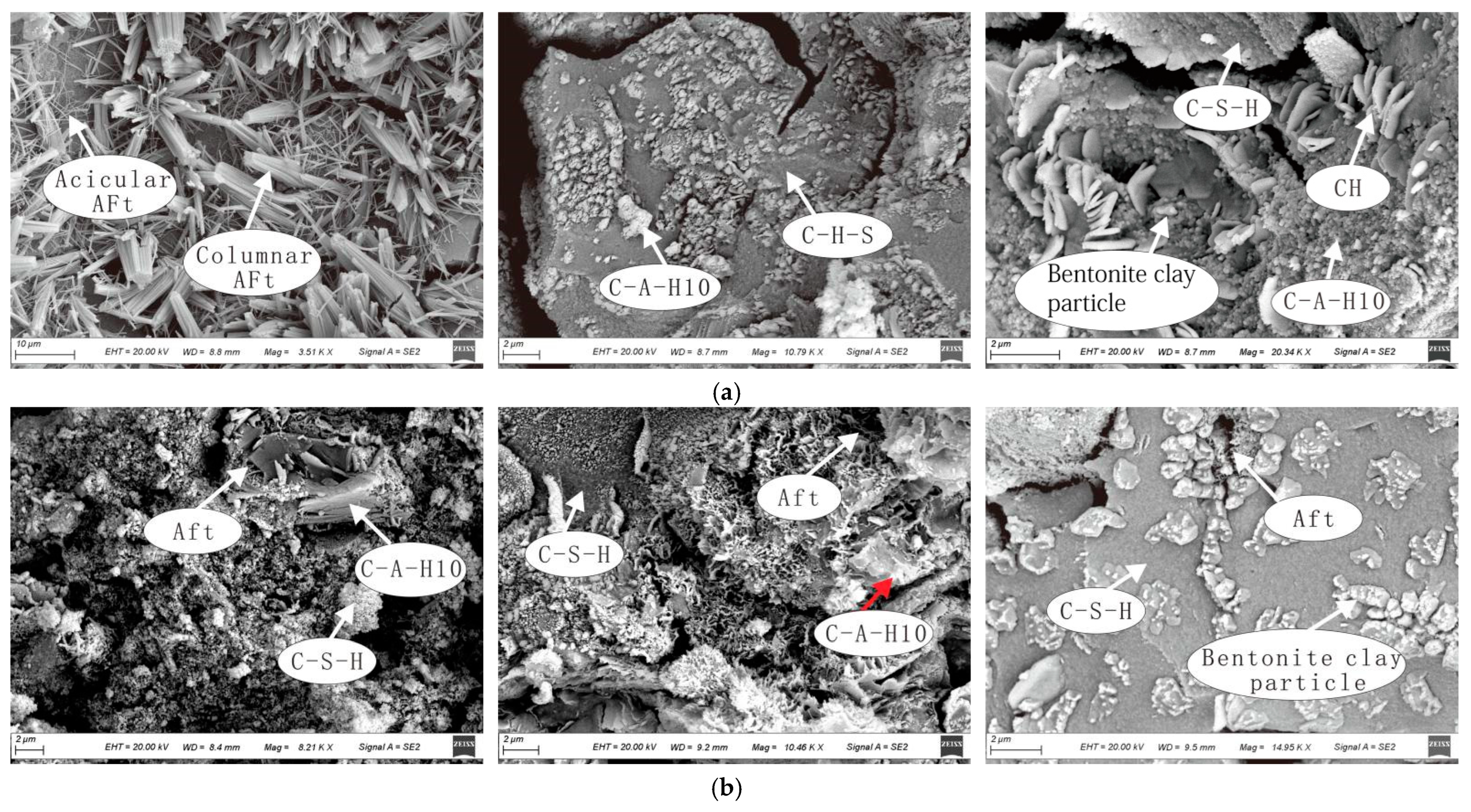Optimization of Composite Grouting Material Proportioning Based on Regression Analysis Method
Abstract
:1. Introduction
2. Material Preparation and Experimental Protocol for Orthogonal Experiments
2.1. Reagents and Materials
2.1.1. Bentonite
2.1.2. Cement
2.1.3. Water Glass
2.1.4. Water-Reducing Agent
2.1.5. Accelerating Admixture
2.2. Experimental Methods
- (1)
- Viscosity test
- (2)
- Setting time test
- (3)
- Compressing test
- (4)
- Scanning electron microscopy test
2.3. Experimental Design
3. Results and Analysis
3.1. Test Results
3.2. Analysis of Test Results
3.3. Analysis of the Influence of Various Single Factors on Material Properties
3.4. Analysis of the Effect of Interactions on Material Performance
3.4.1. Analysis of the Effect Law of Interaction on Y1
3.4.2. Analysis of the Effect Law of Interaction on Y2
3.4.3. Analysis of the Effect Pattern of Interaction on Y3
3.5. Optimization of Results and Applicability Analysis of Regression Analysis Method
4. Sample SEM Characterization
5. Discussion
6. Conclusions
- (1)
- In this study, the results of the orthogonal experiments were analyzed based on regression analysis, and the primary and secondary relationships of the factors affecting the composite grouting material were obtained by single-factor analysis. It can be concluded from the primary and secondary relationships that the most important factors affecting the initial apparent viscosity and setting time are the mass ratio of bentonite to cement (A) and the mass ratio of water glass to slurry (B). The most important factors affecting the compressive strength are the mass ratio of bentonite to cement (A) and the mass permillage of water-reducing agent to cement (C).
- (2)
- Interaction effects on the performance of composite grouting materials are more complex. The following conclusions can be drawn from the multi-factor analysis. The amount of early strength agent has little effect on the viscosity, and the joint action of the water glass and water-reducing agent will make the slurry significantly smoother. When B < 0.3, the setting time will be controlled within 40 s, and with the addition of the early strength agent and the reduction in B, the setting time will become smaller and smaller. When C > 2.5‰ and B < 2.5, the compressive strength of the grouting cementing material is larger and greater than 10 MPa. Such a setting time and compressive strength interval is more suitable for industrial production.
- (3)
- Water glass and bentonite can promote the hydration of cement to a certain extent. The new mesh structure formed by the mixture of multiple substances participating in the hydration of cement is conducive to improving the compressive strength and impermeability of the material.
Author Contributions
Funding
Institutional Review Board Statement
Informed Consent Statement
Data Availability Statement
Conflicts of Interest
References
- Wu, Q.; Zhao, S.Q.; Li, J.S.; Fu, Y.J.; Yin, S.X.; Liu, S.Q. The preparation background and the main points of Rule of mine prevention and cure water disaster. J. China Coal Soc. 2011, 36, 70–74. [Google Scholar] [CrossRef]
- Wu, J.G.; MAO, J.R.; Chai, P. Law of Major&Particular Major Coal Mine Flooding Accidents in China from 2000 to 2017. Saf. Coal Mines 2019, 50, 239–242+103. [Google Scholar] [CrossRef]
- Kang, H.P. Development and prospects of support and reinforcement materials for coal mine roadways. Coal Sci. Technol. 2021, 49, 1–11. [Google Scholar] [CrossRef]
- Kang, H.P.; Feng, Z.Q. Status and Development Tendency of Roadway Grunting Reinforcement Technology in Coal Mine. Coal Min. Technol. 2013, 18, 1–7. [Google Scholar] [CrossRef]
- Sajwan, K.S.; Alva, A.K.; Punshon, T.; Twardowska, I. Coal Combustion Byproducts and Environmental Issues; Springer: New York, NY, USA, 2006. [Google Scholar] [CrossRef]
- Wang, H.; Wang, Q.P.; Min, F.F.; Chen, J. Research Progress of Grouting Sealing Materials. Mater. Rep. 2013, 27, 103–106. Available online: https://kns.cnki.net/kcms2/article/abstract?v=3uoqIhG8C44YLTlOAiTRKjw8pKedNdX5_mkCYmAjR9wCxUY4To2zmk0UD7nyhCb7KF437IJtdyRF1VyCkNQzqOmrj0ETTZ9A&uniplatform=NZKPT (accessed on 20 April 2023).
- Lu, Y.; He, X.F.; Wu, Y.H.; Wang, Y.X.; Cao, X.X.; Qing, P.L. Research Progress on Application of New Cement-based Grouting Materials in Coal Mine Underground. Bull. Chin. Ceram. Soc. 2014, 33, 97–102. [Google Scholar] [CrossRef]
- Li, T.; Gao, Y.; Chen, W. Characteristics of deep Ordovician limestone water and its concentrated application in Ordovician limestone water disaster prevention. J. China Coal Soc. 2018, 43, 262–268. [Google Scholar] [CrossRef]
- Liu, H.B.; Mao, L.T.; Xiao, K.L.; Tang, W.Q.; Ma, W.Z.; Shi, Z.Q.; Li, X.G. Fractal characteristic of fracture surface of high performance concrete with metakaolin. Concrete 2016, 98–100+103. Available online: https://kns.cnki.net/kcms2/article/abstract?v=3uoqIhG8C44YLTlOAiTRKibYlV5Vjs7iAEhECQAQ9aTiC5BjCgn0RoEihDhedrF9t6YykCdCSpAOIIalGuuTgtFhmeYrK3KV&uniplatform=NZKPT (accessed on 20 April 2023).
- Dou, H.J. Investigation on the Performance and Microscopic Characteristics of Complex Cementitious-Sodium Silicate Two-Shot Grouting Materials; China University of Geosciences: Beijing, China, 2014; Available online: https://kns.cnki.net/kcms2/article/abstract?v=3uoqIhG8C475KOm_zrgu4lQARvep2SAk9z9MrcM-rOU4mSkGl_LWfy0Z-S2rvYXl7lwJkuzauZ07xC22xcwNGXUmL1lKheof&uniplatform=NZKPT (accessed on 20 April 2023).
- Zhang, T.; Pan, J.F.; Wan, Y.; Chen, J. The mechanism of action of bentonite to improve the performance of plastic concrete. Yellow River 2007, 267, 78–79+81. Available online: https://kns.cnki.net/kcms2/article/abstract?v=3uoqIhG8C44YLTlOAiTRKgchrJ08w1e7aLpFYbsPrqFhbCHNOCn5fNteBa4s_yKXpFZOoUrEkX33MNymz3MQXsSy6ApK6Nz_&uniplatform=NZKPT (accessed on 20 April 2023).
- Chen, H.L.; Wang, Y.P. Modification of clay material for high-water material based onsulphoaluminate cement. Sichuan Build. Sci. 2010, 36, 240–243. Available online: https://kns.cnki.net/kcms2/article/abstract?v=3uoqIhG8C44YLTlOAiTRKgchrJ08w1e7_IFawAif0mwGyL-3iSMAR_r6HFKJH58ZFb9I2GOnopxmErKqEQyrFL_FtUHTvvNC&uniplatform=NZKPT (accessed on 20 April 2023).
- Zhu, B.; Dai, R.; Li, T. Study on the influence of bentonite on concrete strength. Brick-Tile 2016, 9–11. [Google Scholar] [CrossRef]
- Zhang, G.; Liu, J.; Li, Y.; Liang, J. A pasty clay–cement grouting material for soft and loose ground under groundwater conditions. Adv. Cem. Res. 2017, 29, 54–62. [Google Scholar] [CrossRef]
- Sonebi, M.; Lachemi, M.; Hossain, K.M.A. Optimisation of rheological parameters and mechanical properties of superplasticised cement grouts containing metakaolin and viscosity modifying admixture. Constr. Build. Mater. 2013, 38, 126–138. [Google Scholar] [CrossRef]
- Sheng, Y.; Dai, G.; Li, S. Experimental Study on Impermeability of Impervious Slurry in Landfill. IOP Conf. Ser. Mater. Sci. Eng. 2018, 389, 012035. [Google Scholar] [CrossRef]
- Li, Q. Study on Containment Performance and Chemical Compatibility of Bentonite/Cement/Clay Based In-Situ Barrier Materials for Groundwater Pollution; Jilin University: Jilin, China, 2020; Available online: https://kns.cnki.net/kcms2/article/abstract?v=3uoqIhG8C447WN1SO36whLpCgh0R0Z-iszBRSG4W40qHYXhao9i2hgYDYQbEGYUZhQHeqoBKEndJB8TK9Ep4PHEDn2CSARXe&uniplatform=NZKPT (accessed on 20 April 2023).
- Fan, R.D. Study on Chemical Compatibility and Containment Performance of Soil-Bentonite Cutoff Wall Exposed to Heavy Metal Contaminants; Southeast University: Dhaka, Bangladesh, 2017; Available online: https://kns.cnki.net/kcms2/article/abstract?v=3uoqIhG8C447WN1SO36whLpCgh0R0Z-iTEMuTidDzndci_h58Y6oucscmsnfj_eSRrazk3b3D9p2nVQbX1FyisNB1LbVL1lo&uniplatform=NZKPT (accessed on 20 April 2023).
- Wan, Z.; Zhang, L.; Liu, J.; Xie, Q.Y.; Li, Y.Y.; Li, X.Z. Experimental investigation of anti-seepage performance of improved cement-silicate grouting material. Sci. Technol. Eng. 2018, 18, 277–282. Available online: https://kns.cnki.net/kcms2/article/abstract?v=3uoqIhG8C44YLTlOAiTRKibYlV5Vjs7i0-kJR0HYBJ80QN9L51zrP1Csf9vbFc3jg9iMaK_0m24XENY0BUIjf7sZ0QO8hsOU&uniplatform=NZKPT (accessed on 20 April 2023).
- Zhang, H.T. Bentonite Hardening Slurry Test and Its Application in Engineering; Anhui University of Science and Technology: Huainan, China, 2012; Available online: https://kns.cnki.net/kcms2/article/abstract?v=3uoqIhG8C475KOm_zrgu4lQARvep2SAkWGEmc0QetxDh64Dt3veMp9yrY9X6JzGBZQQb1IZFh-noUeWM0KEB6WEGqglDE30l&uniplatform=NZKPT (accessed on 20 April 2023).
- Shi, Z.L. Study on the Effect of Lithium Salt on the Properties of Cement-Bentonite-Sodium Silicate Solution Slurry; China University of Geosciences: Beijing, China, 2020; Available online: https://kns.cnki.net/kcms2/article/abstract?v=3uoqIhG8C475KOm_zrgu4lQARvep2SAkHr3ADhkADnVu66WViDP_3JSUM9ezThaz-9W35eT_GpmjcxJW-hdmgjvfwrIdQYli&uniplatform=NZKPT (accessed on 20 April 2023).
- Han, T. Experimental Study on the Modification of Bentonite Based Cement Slurry; China University of Geosciences: Beijing, China, 2020; Available online: https://kns.cnki.net/kcms2/article/abstract?v=3uoqIhG8C475KOm_zrgu4lQARvep2SAkHr3ADhkADnVu66WViDP_3JSUM9ezThaz6Abf-xehHPXF3--fLofKZkiIaDJ7ISH5&uniplatform=NZKPT (accessed on 20 April 2023).
- DL/T 5150-2017; Hydraulic Concrete Test Procedure. China Electric Power Press: Beijing, China, 2017.
- Liu, J.; Hu, N.Q.; Xu, B.J.; Yue, X.L.; Qi, B.L.; Zhong, Q. Experiment of cement-based seepage grouting materials for earth-rock dam. J. Shandong Univ. Eng. Sci. 2018, 48, 39–45. Available online: https://kns.cnki.net/kcms2/article/abstract?v=3uoqIhG8C44YLTlOAiTRKibYlV5Vjs7i0-kJR0HYBJ80QN9L51zrP1JTUuvKaKw0ap1MnAm9dpRaJeD4IKLqkanBLLCkmHUl&uniplatform=NZKPT (accessed on 20 April 2023).
- GB/T 1346-2011; Standard Consistency of Cement Water Consumption, Setting Time, Stability Test Method Standard. General Administration of Quality Supervision, Inspection and Quarantine of the People’s Republic of China: Beijing, China, 2011.
- GB/T 17671-2020; Cement Sand Strength Test Method (IOS Method). General Administration of Quality Supervision, Inspection and Quarantine of the People’s Republic of China: Beijing, China, 2019.
- Guo, L.; Zhou, M.; Wang, X.; Li, C.; Jia, H. Preparation of coal gangue-slag-fly ash geopolymer grouting materials. Constr. Build. Mater. 2022, 328, 126997. [Google Scholar] [CrossRef]
- Zhang, L.F.; Liu, L.; Cao, S. Optimization of Alkali Activated Slag-Limestone Powder Mortar by Response Surface Methodology. Mater. Rep. 2017, 31, 15–19. Available online: https://kns.cnki.net/kcms2/article/abstract?v=3uoqIhG8C44YLTlOAiTRKibYlV5Vjs7i0-kJR0HYBJ80QN9L51zrP60G3-8ieN4WbYgGJvmmbyteI271o_Oz6BfGfq75mfL4&uniplatform=NZKPT (accessed on 20 April 2023).
- Wang, H.T.; Wang, X.C.; Zhai, M.H.; Liu, R.T.; Li, Z.F.; Bai, J.W.; Zhang, L.Z.; An, J. Experiment and application of new material for grouting of gangue based aquifer. J. China Coal Soc. 2017, 42, 2981–2988. [Google Scholar] [CrossRef]
- Xia, J.W.; Zhang, L.; Yang, Y.Z.; Yu, L.L. Experimental study on durability of various grouting materials. Huazhong Univ. Sci. Tech. Nat. Sci. Ed. 2018, 46, 99–104. [Google Scholar] [CrossRef]
- Nair, S.; Little, D. Water as the key to expansion of ettringite in cementitious materials. Transp. Res. Rec. 2009, 2104, 55–62. [Google Scholar] [CrossRef]
- Mehta, P.K. Mechanism of expansion associated with ettringite formation. Cem. Concr. Res. 1973, 3, 1–6. [Google Scholar] [CrossRef]
- Shi, C.; Zhang, G.; He, T.; Li, Y. Effects of superplasticizers on the stability and morphology of ettringite. Constr. Build. Mater. 2016, 112, 261–266. [Google Scholar] [CrossRef]
- Zhang, Y.H.; Li, X.Y.; Tong, Y.M.; Yu, H.L.; Yi, Q. Clay Phase Change of Gaomiaozi Bentonite in Simulated Cement Solutions. J. Chin. Ceram. Soc. 2023, 51, 215–225. [Google Scholar] [CrossRef]
- Zhang, L.Y.; Li, Y.; Shui, Y.; Zhang, J.J.; Wu, N.; Yang, J.J.; Bentonite Modified Metatitanate Titanium-lithium Ion Sieve and Its Adsorption Performance. Mater. Rep. 2023, 1–14. Available online: http://kns.cnki.net/kcms/detail/50.1078.tb.20221214.1430.002.html (accessed on 20 April 2023).
- Wang, A.G.; Zhen, Y.; Zhang, Z.H.; Liu, K.W.; Ma, R.; Sun, D.S. Research Progress of Geopolymer Cementitious Material Modification for Improving Durability of Concrete. Mater. Rep. 2019, 33, 2552–2560. Available online: https://kns.cnki.net/kcms2/article/abstract?v=3uoqIhG8C44YLTlOAiTRKibYlV5Vjs7iLik5jEcCI09uHa3oBxtWoGv2K0ZIv4cQLG0CbfNFrGBptlPRbh_XOYxeCLK4sCP_&uniplatform=NZKPT (accessed on 20 April 2023).








| Methylene Blue Index (g/100 g) | Colloid Index (%) | Expansion Multiple | Rate of Water Content (%) | Colloid Ratio (%) | Pulping Rate (m3/t) |
|---|---|---|---|---|---|
| 18~30 | 66 | >10 | <10 | 100 | ≥16 |
| Composition | SiO2 | Al2O3 | TiO2 | Fe2O3 | MgO | CaO | K2O | Na2O | Ignition Loss |
|---|---|---|---|---|---|---|---|---|---|
| Content/% | 63.66 | 16.64 | 0.59 | 4.93 | 1.69 | 0.88 | 1.37 | 4.93 | 10.79 |
| Composition | CaO | SiO2 | AL2O3 | Fe2O3 | SO3 | MgO | F-CaO | Ignition Loss |
|---|---|---|---|---|---|---|---|---|
| Content/% | 58.98 | 23.96 | 6.34 | 3.46 | 2.14 | 0.97 | 1.60 | 2.07 |
| Baume Degree | Density | Modulus | pH Value |
|---|---|---|---|
| 50° Bé | 1.33 | 3.1 | 13 |
| Project | Standard | Result |
|---|---|---|
| Performance | Off-white or off-yellow powder | Qualified |
| Rate of water content (%) | 3.0% | 2.76 |
| Fineness (%) | ≤15.0 | 4.30 |
| Fluidity of cement paste | ≥240 | 240 |
| PH | 8.0 ± 1.0 | 8.46 |
| Mortar water reduction rate (%) | ≥20 | 21 |
| Level (Code) | Factor | |||
|---|---|---|---|---|
| A | B | C (‰) | D (%) | |
| 1 | 0.1 | 0.2 | 0.5 | 1 |
| 2 | 0.15 | 0.3 | 1 | 2 |
| 3 | 0.2 | 0.4 | 1.5 | 3 |
| 4 | 0.25 | 0.5 | 2 | 4 |
| Test Number | Factor LEVEL (code) | Test Result | |||||
|---|---|---|---|---|---|---|---|
| A | B | C | D | Y1 (mPa·s) | Y2 (s) | Y3 (MPa) | |
| 1# | 1 | 1 | 1 | 1 | 615 | 17.62 | 11.71 |
| 2# | 1 | 2 | 2 | 2 | 495 | 14.55 | 14.01 |
| 3# | 1 | 3 | 3 | 3 | 456 | 38.01 | 20.71 |
| 4# | 1 | 4 | 4 | 4 | 330 | 52.39 | 13.43 |
| 5# | 2 | 1 | 2 | 3 | 569 | 25.12 | 11.36 |
| 6# | 2 | 2 | 1 | 4 | 559 | 34.04 | 12.39 |
| 7# | 2 | 3 | 4 | 1 | 432 | 32.89 | 10.53 |
| 8# | 2 | 4 | 3 | 2 | 449 | 57.89 | 7.85 |
| 9# | 3 | 1 | 3 | 4 | 580 | 22.53 | 14.32 |
| 10# | 3 | 2 | 4 | 3 | 610 | 49.76 | 8.70 |
| 11# | 3 | 3 | 1 | 2 | 664 | 34.27 | 9.50 |
| 12# | 3 | 4 | 2 | 1 | 587 | 55.77 | 7.06 |
| 13# | 4 | 1 | 4 | 2 | 780 | 41.26 | 7.01 |
| 14# | 4 | 2 | 3 | 1 | 769 | 43.15 | 6.81 |
| 15# | 4 | 3 | 2 | 4 | 754 | 56.15 | 10.32 |
| 16# | 4 | 4 | 1 | 3 | 710 | 44.91 | 7.22 |
| Material Performance | Factor | Same Level | Average at the Same Level | Range | ||||||
|---|---|---|---|---|---|---|---|---|---|---|
| K1 | K2 | K3 | K4 | |||||||
| Y1 (mPa·s) | A | 1896 | 2009 | 2441 | 3013 | 474.0 | 502.3 | 610.3 | 753.3 | 279 |
| B | 2544 | 2433 | 2306 | 2076 | 636.0 | 608.3 | 576.5 | 519 | 117 | |
| C | 2548 | 2405 | 2254 | 2152 | 637.0 | 601.3 | 563.5 | 538 | 99 | |
| D | 2403 | 2388 | 2345 | 2223 | 600.8 | 597 | 586.3 | 555.8 | 45 | |
| Y2 (s) | A | 127 | 164 | 184 | 235 | 31.6 | 41.0 | 46.1 | 58.9 | 27.2 |
| B | 247 | 206 | 147 | 111 | 61.6 | 51.4 | 36.8 | 27.7 | 33.9 | |
| C | 143 | 176 | 192 | 200 | 35.7 | 43.9 | 47.9 | 50.1 | 14.4 | |
| D | 163 | 174 | 178 | 195 | 40.9 | 43.5 | 44.5 | 48.8 | 7.9 | |
| Y3 (MPa) | A | 60 | 42 | 40 | 31 | 15.0 | 10.5 | 9.9 | 7.8 | 7.1 |
| B | 44 | 42 | 51 | 36 | 11.1 | 10.5 | 12.8 | 8.9 | 3.9 | |
| C | 41 | 43 | 50 | 40 | 10.2 | 10.7 | 12.4 | 9.9 | 2.5 | |
| D | 36 | 38 | 48 | 50 | 9.0 | 9.6 | 12.0 | 12.6 | 3.6 | |
| Material Performance | Degree of Influence | Optimal Ratio |
|---|---|---|
| Y1 | A > B > C > D | A1B4C4D4 |
| Y2 | B > A > C > D | A1B1C1D3 |
| Y3 | A > B > D > C | A1B3C3D4 |
| Number | Factor Level (Code) | Y1 | Y2 | Y3 | |||
|---|---|---|---|---|---|---|---|
| A | B | C | D | ||||
| 1 * | 2.13 | 2.28 | 2.27 | 2.26 | 541.39 | 50.22 | 10.29 |
| 2 * | 1.99 | 2.65 | 2.26 | 2.83 | 533.07 | 50.28 | 10.07 |
| 3 * | 1.72 | 3.00 | 1.61 | 2.87 | 527.96 | 52.44 | 10.27 |
| 4 * | 1.67 | 3.00 | 1.63 | 2.74 | 525.47 | 51.07 | 10.62 |
| 5 * | 1.82 | 2.97 | 2.13 | 2.36 | 519.03 | 50.17 | 10.19 |
| 6 * | 2.01 | 2.65 | 2.15 | 2.97 | 535.95 | 50.89 | 10.04 |
| 7 * | 1.83 | 2.81 | 2.09 | 2.81 | 522.96 | 50.78 | 10.47 |
| 8 * | 2.00 | 2.74 | 2.68 | 2.64 | 517.14 | 50.42 | 10.08 |
| 9 * | 1.74 | 2.92 | 1.33 | 2.99 | 541.22 | 50.96 | 10.23 |
| 10 * | 1.87 | 2.72 | 2.09 | 2.92 | 527.36 | 50.56 | 10.45 |
| 11 * | 2.31 | 2.50 | 2.23 | 2.27 | 534.39 | 50.52 | 10.12 |
| 12 * | 2.03 | 2.26 | 2.10 | 2.13 | 523.13 | 52.81 | 10.49 |
| 13 * | 2.14 | 2.05 | 2.69 | 1.76 | 570.06 | 52.81 | 10.49 |
| 14 * | 2.26 | 1.93 | 2.26 | 2.47 | 513.89 | 50.83 | 11.29 |
| 15 * | 2.16 | 2.37 | 2.32 | 2.34 | 525.60 | 51.03 | 10.11 |
| Material Performance | Predicted Value | Actual Value | Error Rate (%) |
|---|---|---|---|
| Y1 (mPa·s) | 525.6 | 518 | 1.47 |
| Y2 (s) | 51.03 | 56 | −0.09 |
| Y3 (MPa) | 10.11 | 11.1 | −0.09 |
| Material Performance | Cement Slurry [29] | Cement-Clay Slurry [29] | Cement-Water Glass Slurry [30] | Composite Grouting Material |
|---|---|---|---|---|
| 7 d compressive strength (MPa) | 2.30 | 1.16 | 13.25 | 8.3 |
| 28 d compressive strength (MPa) | 9.00 | 2.07 | 17.75 | 11.1 |
| Permeability pressure (MPa) | 0.8 | 0.3 | 0.8 | 1.5 |
| Cost (CNY/t) | 400 | 148 | 600 | 280 |
Disclaimer/Publisher’s Note: The statements, opinions and data contained in all publications are solely those of the individual author(s) and contributor(s) and not of MDPI and/or the editor(s). MDPI and/or the editor(s) disclaim responsibility for any injury to people or property resulting from any ideas, methods, instructions or products referred to in the content. |
© 2023 by the authors. Licensee MDPI, Basel, Switzerland. This article is an open access article distributed under the terms and conditions of the Creative Commons Attribution (CC BY) license (https://creativecommons.org/licenses/by/4.0/).
Share and Cite
Qin, T.; Ni, Y.; Chen, W.; Tao, L. Optimization of Composite Grouting Material Proportioning Based on Regression Analysis Method. Sustainability 2023, 15, 9069. https://doi.org/10.3390/su15119069
Qin T, Ni Y, Chen W, Tao L. Optimization of Composite Grouting Material Proportioning Based on Regression Analysis Method. Sustainability. 2023; 15(11):9069. https://doi.org/10.3390/su15119069
Chicago/Turabian StyleQin, Tao, Yaozu Ni, Weixin Chen, and Lei Tao. 2023. "Optimization of Composite Grouting Material Proportioning Based on Regression Analysis Method" Sustainability 15, no. 11: 9069. https://doi.org/10.3390/su15119069




